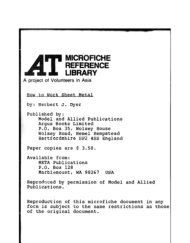You also want an ePaper? Increase the reach of your titles
YUMPU automatically turns print PDFs into web optimized ePapers that Google loves.
B<br />
IE<br />
.<br />
,.<br />
‘NATURAL QYEING =- ’ ,’<br />
IN THE CLASSROOM -- - -. ‘-<br />
Advice -f or~*indi&lual Begintiers, too-’<br />
M-ollie -Harker Rodriguez<br />
ACH T&E the ‘Brooklyn Botanic In autumn, berries, roots and usiall)<br />
Garden offers a course in dyeing some leaves are availab!e. (See page 7).<br />
with plaht materials, among the stu’dents *The time of collect&n will alter the<br />
are a few instruc@s in elementary or colors produced, as ~-31. the location, of<br />
secondary %ools who have come td learn the plant _Ll relation to’ sunlight, rain, :,<br />
a new craft to use in their own class- wind, soil and seasonal weather condi- =,<br />
rooms. Their interest and inquiries,’ cou- tigns. 911 of these factors contribute to<br />
pled wit5 the Garden’s desire to hel; ,the .tGe chpracter of the plglt and therefore to ’<br />
individual beginru>r in t!lis tield, have A the coJ~rs achieved in dyeing. Each time<br />
prompted us to share our experience with . yet; dye wit\1 vcgtitable -tliuterinls it ‘is an<br />
readers. t csperiri$it because *every, ,collection of \<br />
I)ytlin: .l>litIltS is x11 i!ltl:ipuing rrnft. plants. iS> tiniqnc. Repeatcd use 05 the<br />
Ili5tl~ric*:~lli” lll:~llt5 ‘XPIY the Ilt:iin same dye uff will prove how varied the<br />
’ source for tlir produc~tiol1 ;~nd m:4iuf$c- -resulls caA/ e.<br />
“F, I -<br />
.<br />
.<br />
I’<br />
tllW Of :111 ktlf? tlyC5 IlSPd to color fill&J:iCS ’ -’<br />
?*,<br />
UIllil tlir rllitl(lltl of the 19th century. Wool 3<br />
><br />
Totlay :I ,gf:owing IlLllllbr~~ of people ilIT<br />
Most natural’ dyes yield more brrl’liant<br />
~tItll~;c.I,\.tAI:ill~-tltis art :tli(l ilre allsious to<br />
2nd lasting colors if used with*wool. Wool<br />
i1))/'1! it to f:lhr’ics ;LS :1 Substitute-for the<br />
is mind tissue and ‘!lue to-tlie substazrces<br />
:trliltIkv (I>.(>.- wtlic*lk :II‘(’ now ~01111110111~<br />
in its cell w’~lls, the molecules of the mar- 9 ’<br />
114.<br />
There are IIKXI~ possibilities here to<br />
dants and dyes are bound rhore easily to<br />
stimulate the plinds -of young people. For<br />
it than- to the celluloid constitu&ts sf .<br />
children, it is learning how to use plants<br />
plant fibers. However, to make compariin<br />
the same ways as did their ancestors:<br />
sons you might add to the dyebath a small ’<br />
Experiments in dyeing might accompany<br />
~picre of cotton sheet or jersey along with r. ’<br />
work in history or social studies courses,<br />
the yarn.<br />
Or comple&ent aIf art course, especially if I. For classroom use, 2-ply ‘yain is very a<br />
jhere is a field trip scheduled to a museum satisfnctory because it,.dyes quickly and<br />
exhibiting tapestries or weavings. Aqoth- is easy to handle. If possible, natural ,m- ’ a<br />
er approach is to include dyei’ng methods bleached wool should be used but bleached<br />
! as part of a study of the economic uses of wool can be substiMed if it is ,more readplants.<br />
3 ily available. The yarn should be tied in$o<br />
skeins with white cotton twipe for mati-<br />
__ Co!lecting the <strong>Plant</strong>s 2 ageabili_ty in the dyepbt, as shown on u<br />
-<br />
Collecting the plant tnatertal is done<br />
when the pari-icular type of plant desired<br />
for use ii “ready,” that is! when mosi of<br />
the dye-producin g substances are concenpage<br />
12 of Handbook 012 Dye <strong>Plant</strong>s and<br />
TIl/e;)lq. Wash the wool in several solutions<br />
of mild ,soapy warm water and rinse<br />
it wrll hrfore dyeing. Y<br />
trated in the part you want to collect. Work with small quantities of wool ‘ai’<br />
’ Barks and young shoots can be gathered such as l/Z oz. dry -height skeins. They - :<br />
in early spring. Throughout spring and, req,tii& a minimum of plant material and<br />
‘summer there will’be leaves and fl0weS-s to only a.‘qunrt or so 6f dyebath solution. .*<br />
use fresh or to cut and de for later use. Good corog“samples. can be obtained-with<br />
.--<br />
/<br />
8<br />
/I<br />
d 1<br />
a<br />
:’<br />
.<br />
),.<br />
c







